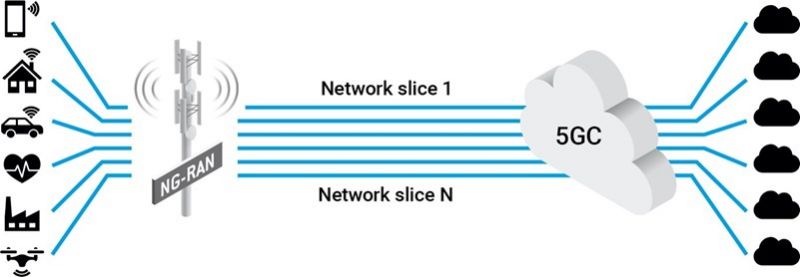**5G and Ethernet**
The connections between base stations, and between base stations and core networks in 5G systems form the foundation for terminals (UEs) to achieve data transmission and exchange with other terminals (UEs) or data sources. The interconnection of base stations aims to improve network coverage, capacity and performance to support various business scenarios and application requirements. Therefore, the transport network for 5G base station interconnection requires high bandwidth, low latency, high reliability, and high flexibility. 100G Ethernet has become a mature, standardized and cost-effective transport network technology. The requirements for configuring 100G Ethernet for 5G base stations are as follows:
**One, Bandwidth Requirements**
5G base station interconnection requires high-speed network bandwidth to ensure data transmission efficiency and quality. The bandwidth requirements for 5G base station interconnection also vary according to different business scenarios and application requirements. For example, for enhanced Mobile Broadband (eMBB) scenarios, it needs to support high-bandwidth applications such as high-definition video and virtual reality; for Ultra-Reliable and Low Latency Communications (URLLC) scenarios, it needs to support real-time applications such as autonomous driving and telemedicine; for massive Machine Type Communications (mMTC) scenarios, it needs to support massive connections for applications such as Internet of Things and smart cities. 100G Ethernet can provide up to 100Gbps of network bandwidth to meet the needs of various bandwidth-intensive 5G base station interconnection scenarios.
**Two, Latency Requirements**
5G base station interconnection requires low-latency networks to ensure real-time and stable data transmission. According to different business scenarios and application requirements, the latency requirements for 5G base station interconnection also vary. For example, for enhanced Mobile Broadband (eMBB) scenarios, it needs to be controlled within tens of milliseconds; for Ultra-Reliable and Low Latency Communications (URLLC) scenarios, it needs to be controlled within a few milliseconds or even microseconds; for massive Machine Type Communications (mMTC) scenarios, it can tolerate within a few hundred milliseconds. 100G Ethernet can provide less than 1 microsecond end-to-end latency to meet the needs of various latency-sensitive 5G base station interconnection scenarios.
**Three, Reliability Requirements**
Interconnection of 5G base stations requires a reliable network to ensure the integrity and security of data transmission. Due to the complexity and variability of network environments, various interferences and failures may occur, resulting in packet loss, jitter or interruption of data transmission. These issues will affect the network performance and business effects of 5G base station interconnection. 100G Ethernet can provide various mechanisms to improve network reliability, such as Forward Error Correction (FEC), Link Aggregation (LAG), and Multipath TCP (MPTCP). These mechanisms can effectively reduce packet loss rate, increase redundancy, balance load, and enhance fault tolerance.
**Four, Flexibility Requirements**
Interconnection of 5G base stations requires a flexible network to ensure adaptability and optimization of data transmission. Since 5G base station interconnection involves various types and scales of base stations, such as macro base stations, small base stations, millimeter wave base stations, etc., as well as various frequency bands and signal modes, such as sub-6GHz, millimeter wave, non-standalone (NSA), and standalone (SA), a network technology that can adapt to different scenarios and requirements is needed. 100G Ethernet can provide various types and specifications of physical layer interfaces and media, such as twisted pair, fiber optic cables, backplanes, etc., as well as various rates and modes of logical layer protocols, such as 10G, 25G, 40G, 100G, etc., and modes like full duplex, half duplex, auto-adaptive, etc. These characteristics give 100G Ethernet high flexibility and compatibility.
In summary, 100G Ethernet has advantages like high bandwidth, low latency, reliable stability, flexible adaptation, easy management, and low cost. It is an ideal choice for 5G base station interconnection.
Chengdu Concept Microwave is a professional manufacturer of the 5G/6G RF components in China , including the RF lowpass filter , highpass filter , bandpass filter , notch filter/band stop filter , duplexer,Power divider and directional coupler . All of them can be customized according to your requrements .
Welcome to our web : www.concept-mw.com or reach us at: sales@concept-mw.com
Post time: Jan-16-2024


